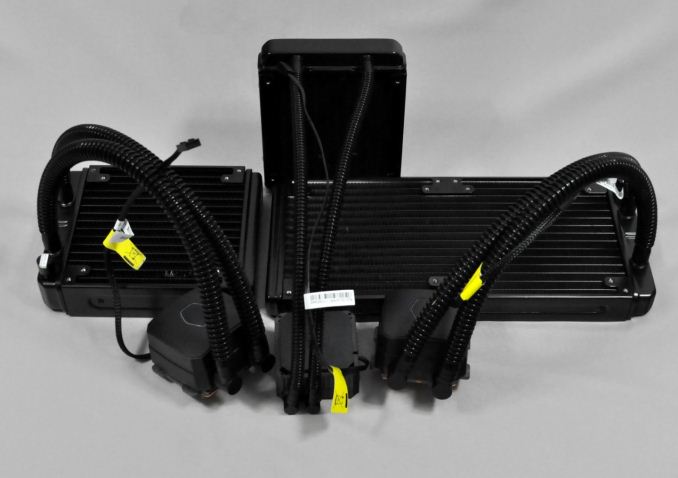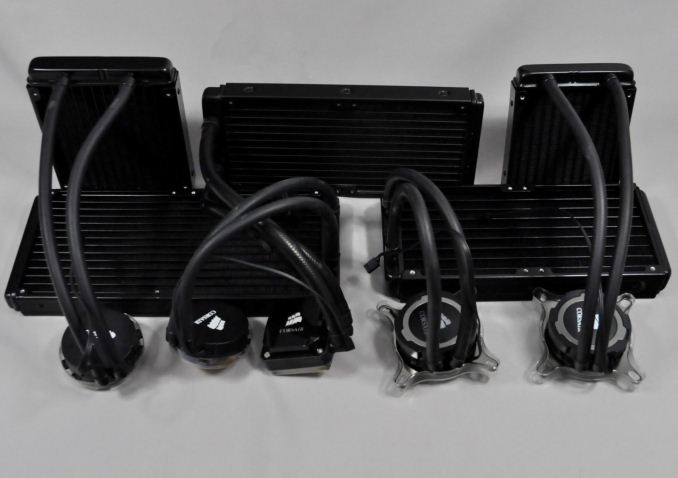Closed Loop AIO Liquid Coolers: 14-way Mega Roundup Review
by E. Fylladitakis on February 12, 2014 7:00 AM ESTCooler Master
It would seem that Cooler Master simply wanted to create the best performing AIO coolers available. In that respect, they certainly managed to do so, as their Nepton series coolers are constantly at the top of our high load thermal performance charts. On the other hand, one would have to be at least partially deaf in order to use these coolers with the fans anywhere near their maximum speed. Even with their voltage reduced down to 7V, both kits are rather noisy. It is not possible to run these kits quiet even if you reduce the voltage even further, as the fans are clearly audible from 1 meter away even at just 4.7V, the minimum voltage required to start them. Therefore, we simply cannot recommend them to anyone seeking a quiet cooling solution.
The Seidon 120V however is an entirely different product. Priced at just $49.99, it is more of an alternative to an average air cooler than competition for liquid cooling solutions. It fares relatively well at lower loads but its performance diminishes with thermal loads greater than 150W. With an average thermal resistance slightly above 0.014 °C/W, it will most likely be unable to compete with most extreme performance air coolers, and it has a particularly noisy pump, making it noisier than other 120mm AIO coolers. However, it has other merits, as it does not stress the motherboard with its weight and it requires very little space around the CPU area, making it ideal for special builds and/or systems that are moved around a lot.
Corsair
Corsair has such a vast selection of AIO cooling products that we could make a roundup just for them. Each of the five coolers that they shipped us for this roundup displays entirely different behavior; thus, each of them is suitable for a different type of user.
With the H75 Corsair is offering a compact 120mm AIO cooler but with two 120mm fans for extra performance. The H75 performs relatively well, although it generally does better at thermal loads lower than 150W due to the low capacity of its small radiator. The use of two fans however increases the noise of the system, giving the advantage to Enermax's Liqmax 120S if low-noise operation is the top priority.
The 140mm H90 on the other hand displays great all-around performance and very low noise levels. Even with its fan constantly running at maximum speed, the H90 can be considered fairly discreet and is comfortable for everyday use. If quiet computing is what drives you, the H90 deserves a very strong consideration.
Corsair informed us that the H100i is their most popular AIO cooler and we can see why. Despite its size, the H100i easily competes with coolers using significantly larger radiators. The stock fans have a wide operating range and the USB interface allows the user to adjust the performance/noise ratio to meet his or her exact needs. Furthermore, the size of the radiator makes the H100i compatible with a relatively wide array of cases.
After looking at the performance figures of the H100i, we felt disappointed by the performance of the newly released H105. The H105 hardly performs much better and it only does so when the thermal load is very high. Unfortunately, the thicker radiator can create compatibility issues and it also is more expensive than the H100i, all while lacking the USB interface that the H100i has. It is hard to recommend the H105 over the H100i for the slightly better thermal performance alone, unless of course maximum thermal performance is virtually the only concern of the user and a larger radiator cannot fit into the system.
Finally, the last AIO cooler from Corsair that we have tested, the Hydro H110, possibly stands as the performance winner of this roundup. Although it does not have the best thermal performance, it is very close to the top of the charts and manages to do so while maintaining very low noise levels. However, the size of the radiator limits the compatibility of the cooler with only a handful of cases currently available and, considering that the retail price of the H110 is over $125 at the time of this review, it is a costly thermal solution.












139 Comments
View All Comments
thewhat - Wednesday, February 12, 2014 - link
"the Corsair H90 ... is entirely silent when its fan's voltage is reduced down to 7 Volts."I've tried some of the quietest fans in existence and at 920 rpm they weren't even quiet, let alone entirely silent.
Anything over 600-700 rpm is usually audible, but quiet. And at around 800 rpm it stops being quiet.
Maybe we just have different standards for quietness.
But then liquid cooling was never a good option for silence freaks, anyway.
E.Fyll - Wednesday, February 12, 2014 - link
There are great differences between fans, even at same RPM, depending on their engine and wing design. This is also being displayed in this review, as fans running at nearly the same RPM have vast performance differences. At one meter away, I could not possibly discern any noise coming from the H90, that is why I classified it as silent. If however you were to install it inside a metallic case with many openings, which would reflect and enhance the noise level, you might be able to notice a low-tone humming noise - that's a maybe, a mere assumption on my part.Aikouka - Wednesday, February 12, 2014 - link
I don't know if anyone else considers it to be worthwhile, but I wouldn't mind seeing how well these coolers work when you remove one of the commonly-changed variables: the fans. I rarely ever use stock fans, and along those lines, it would be interesting to see what would happen if the same fans (per standard size -- 120mm and 140mm) were used on each cooler.jjj - Wednesday, February 12, 2014 - link
Pretty pointless without a comparison with the same fans and some air coolers.silenceisgolden - Wednesday, February 12, 2014 - link
I'm a little disappointed that patent trolls kept the Swiftech offerings from this list, but that's how things are I guess.casteve - Wednesday, February 12, 2014 - link
Thanks for the review. What was the ambient noise level and the noise meter used for the test?E.Fyll - Wednesday, February 12, 2014 - link
My apologies, I should have added this into the review. Will do so from now on. The meter is an Extech HD600 and the background noise level is 30.4 dB(A) (+/- about 0.5 dB(A), depending on the night I perform a test).casteve - Wednesday, February 12, 2014 - link
Thanks. As this meter has a lower limit of 30dB(A) and an accuracy of +/-1.4dB, your ambient is probably quieter and you are just seeing the low end of what the meter can do. Sort of expected unless (as you say) you have an expensive set up for the test equipment. Get Anand to shill out the $'s for a 10dBA microphone and an anechoic chamber for that spare bedroom. :)Some terms - if the meter is reading sound pressure level, then it's dB(A) SPL, which is referenced to 20 micro Pascals (0 dB). So, 0 dB(A) SPL is the threshold of hearing, 20-30dB(A) SPL is a calm room.
pcfxer - Wednesday, February 12, 2014 - link
All of these are way too loud. At 30+ dB, none of these coolers hit the envelope for someone who actually cares about "silence" and noise.E.Fyll - Wednesday, February 12, 2014 - link
You are confusing dB and dB(A), I am afraid. The background noise of my room at 2:00AM is 30.4 dB(A). Sub-35 dB(A) levels are generally impossible to notice by a human ear. Sub-30 dB(A) levels are next to impossible to record with anything less than science lab-grade equipment. There is no handheld or desktop dB(A) meter that can perform such readings. If you have seen reviews stating sub-30 dB(A) levels, make sure to check their methodology (given that there is any). Either the meter cannot read lower than 30 dB(A) (and/or will display a bogus reading, as most cheap Chinese meters do) and the review is a fictional text or their methodology is based on dB readings, not dB(A) readings, which is useless to a consumer.